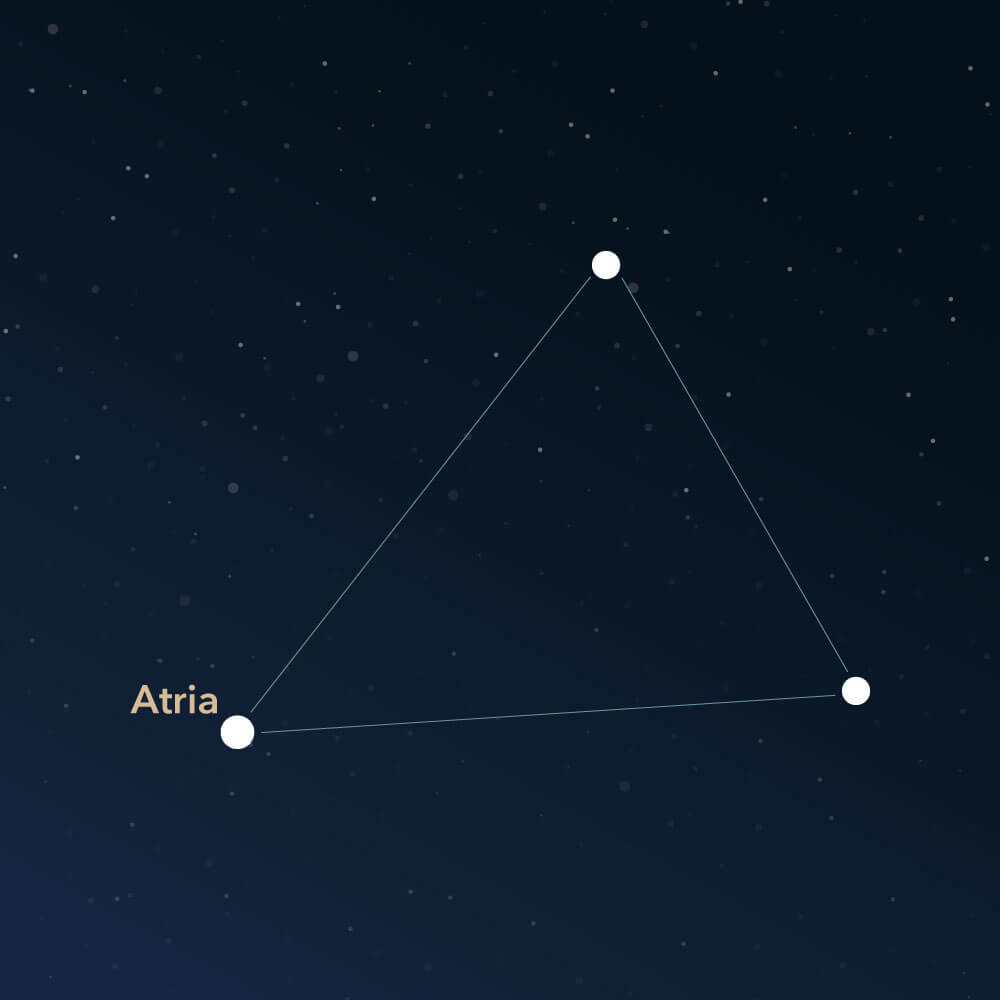The constellation Triangulum Australe
Caractéristiques
- Nom latin
- Triangulum Australe
- Hémisphère
- Hémisphère sud
- Visibilité
- April - July
- Région
- 110 deg²
- Étoile la plus brillante
- Atria (HIP number 82273)
- Spécialités
- Galaxies, planetary nebulae, open star clusters

The Triangulum Australe, Latin for Southern Triangle, is a small constellation in the southern sky. It was introduced by Peter Plancius in 1698 and included in celestial maps. There are some interesting deep-sky objects in the area.
Hemisphere, visibility, and area
The constellation Triangulum Australe lies in the southern celestial sky and is visible from the entire southern hemisphere. North of the equator it can only be observed from locations that are south of the 20th parallel. This corresponds to regions such as the south of Cuba or Guadalajara in Mexico, meaning it cannot be seen from the latitudes of Europe, the United States, or Canada.
The best time to observe the Triangulum Australe is from April to July. It stretches across just 110 square degrees of the night sky, making it the 83rd largest constellation out of all 88.
In star charts, it is represented by the three brightest stars, which form a simple triangle when connected. The brightest star in the constellation is Atria (Latin: α Trianguli Australis, Alpha Trianguli Australis), which has an apparent magnitude of roughly 1.9 and is located about 400 light-years away from earth.
Due to the relatively faint stars and small size of the constellation, finding the Triangulum Australe in the night sky can be challenging. However, the neighboring constellations can be used as a helpful guide. To the north and east lie the similarly small constellations of Norma and Circinus, respectively. To the south is the constellation of Apus, and to the west is the Ara.
Specialties in the constellation
The region of the Triangulum Australe is located in the Milky Way, which provides some exciting objects such as planetary nebulae, various galaxies, and an open star cluster.
The open star cluster NGC 6025 offers a particularly beautiful sight. Although it cannot be observed with the naked eye, about 60 stars can already be seen in prism binoculars. The star cluster is approximately 2,700 light-years away, and its total brightness is given as around 5.1. The object was discovered by the French astronomer Nicolas Louis de Lacaille in 1751.
History
The Triangulum Australe was already mentioned in the travel reports of Spanish and Portuguese sailors in the early 16th century. Nevertheless, Dutch sailors and astronomers are usually mentioned as the discoverers of the constellation.
At the end of the 16th century, a Dutch fleet under the command of Captain Pieter Dirkszoon Keyser traveled to the legendary Spice Islands to create new trading relationships. On behalf of the Dutch astronomer Peter Plancius, Keyser and Frederick de Houtman measured the positions of 135 stars during this journey.
Based on this data, 12 new constellations were defined and included in Plancius' celestial maps. Among them was the Southern Triangle, initially referred to as "Den Zuyder Trianghel" and later renamed "Triangulum Australe."
In 1603, Johann Bayer eventually included the star constellation in his celestial atlas Uranometria.
PubliéLire d'autres articles intéressants

An overview of all 88 constellations
Learn more about all 88 constellations and read interesting information about the mythology, visibility, and features.

Application Planétarium
Découvrez le ciel nocturne avec notre application de planétarium !
Disponible pour iOS et Android.

Nommez une étoile dans la constellation Southern Triangle
Name a star in a constellation and create something that lasts for eternity.